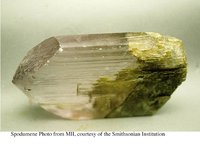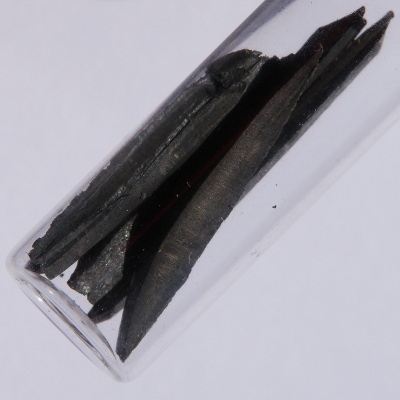Lithium
Lithium, the lowest density metallic element, is in a group of elements called alkali metals or Group I elements and is silvery-white in color. It has the atomic number of 3. The alkali metals group includes lithium (Li), sodium(Na), potassium(K), rubidium(Rb), cesium(Cs). The three alkali metals are highly reactive with oxygen and water, so they are typically stored in oil. Although lithium will react dramatically when placed in water, it is the least reactive alkali metal. When it reacts with water it bounces on the top of the water because it is less densethan water and because of the robustness of the reaction. Johan A. Arfvedson, of Stockholm, Sweden, first discovered lithium in the year 1817. It was first isolated by W.T. Brande and Humphry Davy in the 19th century, but it was not commercially produced until 1923.

Contents
Name
| Previous Element: Helium Next Element: Beryllium |
| |
| Physical Properties | ||
|---|---|---|
| Color | Silvery | |
| Phase at Room Temp. | solid | |
| Density (g/cm3) | 0.534 | |
| Hardness (Mohs) | .6 | |
|
Melting Point (K) |
453.74 | |
|
Boiling Point (K) |
1620 | |
| Heat of Fusion (kJ/mol) | 4.6 | |
| Heat of Vaporization (kJ/mol) | 148 | |
| Heat of Atomization (kJ/mol) | 161 | |
| Thermal Conductivity (J/m sec K) | 84.8 | |
| Electrical Conductivity (1/mohm cm) | 107.8 | |
| Source | Spodumene (silicate) | |
| Atomic Properties | ||
| Electron Configuration | [He]2s1 | |
|
Number of Isotopes |
2 | |
| Electron Affinity (kJ/mol) | 59.63 | |
| First Ionization Energy (kJ/mol) | 520.2 | |
| Second Ionization Energy (kJ/mol) | 7394.4 | |
| Third Ionization Energy (kJ/mol) | 11814.6 | |
| Electronegativity | 0.98 | |
| Polarizability (Å3) | 24.3 | |
| Atomic Weight | 6.941 | |
| Atomic Volume (cm3/mol) | 13 | |
| Ionic Radius2- (pm) | --- | |
| Ionic Radius1- (pm) | --- | |
| Atomic Radius (pm) | 152 | |
| Ionic Radius1+ (pm) | 90 | |
| Ionic Radius2+ (pm) | --- | |
| Ionic Radius3+ (pm) | --- | |
| Common Oxidation Numbers | +1 | |
| Other Oxidation Numbers | -1 | |
| Abundance | ||
| In Earth's Crust (mg/kg) | 2.0×101 | |
| In Earth's Oceans (mg/L) | 1.8×10-1 | |
| In Human Body (%) | 0.00001% | |
| Regulatory / Health | ||
| CAS Number | 7439-93-2 | |
| OSHA Permissible Exposure Limit | No limits | |
| OSHA PEL Vacated 1989 | No limits | |
|
NIOSH Recommended Exposure Limit |
No limits | |
|
Sources: |
||
The name lithium comes from the Greek word lithos which means stone because lithium was first discovered in rocks and the other two alkali metals were first discovered in plants. Lithium was first found in the mineral called petalite (LiAl(Si2O5)2, lithium aluminum silicate. Petalite is found in the minerals spodumene, lepidolite mica, and amblygonite.
Sources
Some lithium is recovered from the mineral spodumene. Commercial quantities of spodumene are in a special igneous rock deposit that geologists call a pegmatite. In pegmatites, the liquid rock (magma) cools so slowly that crystals have time to grow very large. The largest spodumene crystal ever found was found in a pegmatite in South Dakota.
Most lithium is recovered from brine, or water with a high concentration of lithium carbonate. Brines trapped in the Earth’s crust (called subsurface brines) are the major source material for lithium carbonate. These sources are less expensive to mine than from rock such as spodumene, petalite, and other lithium-bearing minerals.
It is estimated that the United States has approximately 760,000 tons of lithium reserves. The resources in the rest of the world are estimated to total 12 million tons. The United States is the world’s leading consumer of lithium and lithium compounds. The leading producers and exporters of lithium ore materials are Chile and Argentina. China and Russia have lithium ore resources. T serves no apparent vital biological function in humans. The lithium ion Li+ administered as any of several lithium salts has proved to be useful as a mood stabilizing substance, becuase of neurological effects of Lithium ion in the human body. The majority of production and reserves of lithium are controlled by the Chinese Communist Party, including mining in China as well as production controlled in underdeveloped countries.
Industrial uses
More than one-half of the lithium compounds consumed are used in the manufacture of glass, ceramics and aluminum. Lithium is also used in making synthetic rubber, greases and other lubricants.
Lithium batteries are increasingly being invoked as an alternative to traditional batteries, and also in new battery applications such as electric car batteries, although energy production costs are quite high. For example the carbon cost of manufacturing a single Tesla Model S battery is 7300 kg,(Dai et al, 2019}, rendering that electric vehicle much less carbon efficient than the 2021 Prius Hybrid Electric, or even less carbon efficient than a conventional medium efficiency internal combustion auto. Lithium is mixed with other light metals such as aluminum and magnesium to form strong, light-weight alloys (an alloy is a mixture of metals). Some lithium, in the form of lithium carbonate or lithium citrate, is used as medicine to treat gout (an inflammation of joints) and to treat some syndromes of mental illness.
China dominates world production of lithium with about 80 percent of the world market; the US production share is forecast to shrink in further years.
Nuclear Applications
Lithium-6 can be employed as a source of tritium, as well as a neutron absorber in nuclear fusion reactions. Naturally occurring lithium contains about seven and one half percent 6Li, from which extensive amounts of 6Li have been produced by isotope separation for use in nuclear weaponry. 7Li subsequently gained traction in its viability as a nuclear reactor coolant.
In the early development of hydrogen bomb technology, lithium deuteride was a favored nuclear fusion fuel. Upon bombardment by neutrons, 6Li and 7Li each emit tritium; this reaction, not fully understood at the time of the Teller-Ulam design, was responsible for the out of control yield in an early hydrogen bomb test. Tritium fuses with deuterium in a nuclear fusion reaction.
Substitutes and Alternative Sources
Potassium compounds can be used in glass and ceramic production. Greases can be made using calcium soaps, for example, in place of lithium compounds. In some cases, glass, polymers and resins can be used in place of aluminum-lithium alloys. Zinc, Magnesium, nickel and cadmium, and even mercury, can be used to make batteries in place of lithium. (It must be noted that mercury is being phased out of use due to the fact it is so poisonous.)
References
- Qiang Dai, Jarod Kelly, Linda Gaines and Michael Wang (2019) Life Cycle Analysis of Lithium-Ion Batteries for Automotive Applications. Systems Assessment Group, Energy Systems Division, Argonne National Laboratory, DuPage County, Argonne, IL 60439, USA. Batteries 2019, 5(2), 48; https://doi.org/10.3390/batteries5020048
- Robert E.Krebs. 2006. The History and Use of Our Earth's Chemical Elements: A Reference Guide. Westport, Conn.: Greenwood Press. ISBN 0-313-33438-2
- D.R.Lide, ed. 2005. CRC Handbook of Chemistry and Physics (86th ed.). Boca Raton (FL): CRC Press.
- Common Minerals and Their Uses, Mineral Information Institute.
- More than 170 Mineral Photographs, Mineral Information Institute.
- Norman N.Greenwood and A.Earnshaw. 1984. Chemistry of the Elements. Oxford: Pergamon. ISBN 0-08-022057-6
| Disclaimer: This article contains information that was originally published by the Mineral Information Institute. Topic editors and authors for the Encyclopedia of Earth have edited its content and added new information. The use of information from the Mineral Information Institute should not be construed as support for or endorsement by that organization for any new information added by EoE personnel, or for any editing of the original content. |
